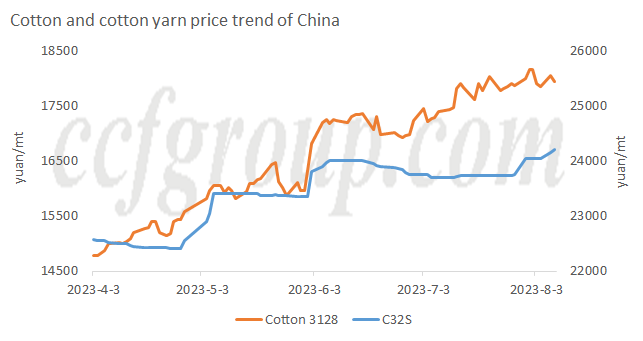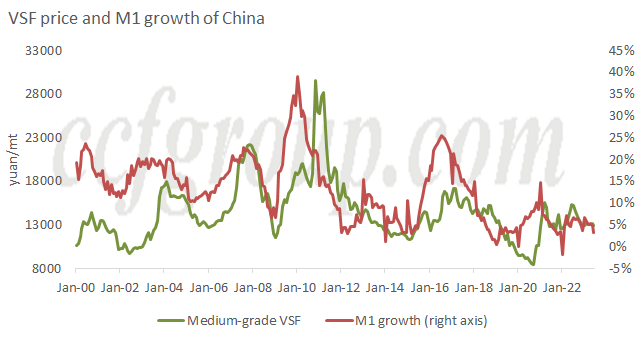Can we expect a booming VSF market in Sep and Oct?
Before proceeding with further analysis, it must be stated that in the current economic environment, it is difficult to find certain opportunities. It is unlikely to see a significant upward trend in which everything is ready. The following analysis is only a probabilistic analysis based on past events and future changes.
First, let us present the conclusion that we believe there is a high probability of a prosperous situation known as "Golden Sep and Silver Oct" in 2023. This judgment is based on the following points.
Historical trend: we have analyzed VSF price change in the past ten years from Aug 1 to Sep 30. During the period under review, there have been only four instances of price decreases in Aug and Sep. Two of them occurred during the COVID-19 pandemic, and all four instances happened after a significant increase in VSF prices in the first half of the year. In the seven years before the pandemic, there were only two instances of price decreases, both with specific historical backgrounds. The rest years generally experienced an upward trend during this period.
| VSF price change in the past ten years (unit: yuan/mt) | ||||
| Year | 1-Aug | 30-Sep | Change | Background |
| 2013 | 13,300 | 12,800 | -500 | Overlapping of three phases, clearing of previous risks. |
| 2014 | 11,800 | 12,000 | 200 | |
| 2015 | 13,200 | 14,380 | 1,180 | |
| 2016 | 15,900 | 16,950 | 1,050 | |
| 2017 | 15,925 | 16,190 | 265 | |
| 2018 | 14,030 | 15,180 | 1,150 | |
| 2019 | 11,770 | 10,730 | -1,040 | Release of million tons of capacity previously, China-US trade war |
| 2020 | 8,300 | 9,100 | 800 | |
| 2021 | 13,170 | 12,050 | -1,120 | Second peak of the COVID-19 pandemic |
| 2022 | 14,820 | 13,500 | -1,320 | Tightening lockdown measures, inflation falls |
| 2023 | 12,400 | |||
Downstream market: generally speaking, Jul and Aug are considered the slack season for the textile market. Usually, due to the slack season and high temperature, yarn mills' operating rates decrease in Jul. In the past decade, eight of them have experienced a decline in Jul. Only two years remained stable, and one of them is the current year. A stable operating rate has two effects: maintaining raw material consumption and creating sales pressure for yarn mills.
| Rayon yarn operating rate change in Jul of the past decade (unit: %) | |||
| Year | 1-Jul | 31-Jul | Change |
| 2014 | 71 | 66.5 | -4.5 |
| 2015 | 74.4 | 70 | -4.4 |
| 2016 | 74.3 | 74.2 | -0.1 |
| 2017 | 72.5 | 72 | -0.5 |
| 2018 | 78 | 77.5 | -0.5 |
| 2019 | 76 | 75.8 | -0.2 |
| 2020 | 49 | 49 | 0 |
| 2021 | 55 | 52 | -3 |
| 2022 | 52 | 44.5 | -7.5 |
| 2023 | 51.5 | 51.5 | 0 |
Note: the differences in operating rate between different years in the table are mainly caused by the increase in the blending ratio of sample companies. Therefore, direct comparisons are not advisable.
Considering the impact of the high operating rate on yarn mills, one indicator worth examining is the inventory. Let us compare the changes in yarn inventory over the past decade. In most years, yarn inventory showed an upward trend in Jul, but in 2023, despite no decline in the run rate, yarn inventory remained stable in Jul. This data indicates that the off-season in Jul was not as sluggish as usual.
| Rayon yarn inventory change in Jul of the past decade (unit: day) | |||
| Year | 1-Jul | 31-Jul | Change |
| 2014 | 26.5 | 27 | 0.5 |
| 2015 | 14.8 | 15.4 | 0.6 |
| 2016 | 15.7 | 21.5 | 5.8 |
| 2017 | 16.2 | 15.1 | -1.1 |
| 2018 | 15 | 18.5 | 3.5 |
| 2019 | 22.5 | 22 | -0.5 |
| 2020 | 41 | 45 | 4 |
| 2021 | 26 | 20 | -6 |
| 2022 | 25 | 30.5 | 5.5 |
| 2023 | 28.5 | 28.5 | 0 |
Cotton as a related product: as we know, initially, viscose was popularly referred to as "artificial cotton." Due to the similar physical properties, cotton and viscose products have certain substitution effects. We have analyzed the correlation between cotton and viscose in the past. In the long term, there is no strong correlation, but there are some years with synchronous trends. These years share a common characteristic, namely, when cotton prices rise, this trend effectively transmits downstream.
This year, cotton futures experienced a significant price increase starting from Apr, but mainly due to factors such as a decrease in cotton production for the next year and low current cotton inventory. However, during this period, yarn mills still consumed low-priced cotton purchased earlier. Therefore, as can be seen in the following figure, the increase in cotton yarn prices significantly lagged behind the rise in cotton prices. However, with the consumption of low-cost cotton raw materials, downstream buyers have to face high-priced cotton. As Sep marks the beginning of a new crop year, it is difficult for cotton prices to experience a significant decline in the short term. Under such circumstances, the spinners that have to procure high-priced cotton will inevitably raise yarn prices. The transmission of high-priced cotton to the textile industry is starting to take effect, and may eventually have a substantial impact on the VSF industry chain.

Monetary factors: since 2023, China's monetary policy has been consistently loose to promote economic recovery. Total new loans in the first half of the year reached 15 trillion yuan, and the year-on-year growth rate of M2 money supply has been in double digits. Although the year-on-year growth rate of M1 is slightly lower, it reached a recent high of 6.7% in Jan. Compared to M2, M1 has a greater impact on VSF price. Currently, the M1 does not support a significant increase in VSF prices. However, unlike in the past, M1 has greater elasticity and room for growth based on the large base of M2. Considering that monetary policy usually has a lagged effect of around six months, the monetary injection in the first quarter cannot be ruled out as having a positive impact in Sep.

In conclusion, there are favorable opportunities for VSF in Sep. Based on the off-season's performance, coupled with the surge in cotton prices and ample liquidity, there is a high probability of a prosperous situation. However, as stated at the beginning, the current economic environment is relatively complex, and there is no certainty of a significant upward trend. Uncertainties in overseas and end-user demand exist. All positive prospects are only probabilistic, and their realization depends on collective actions and efforts.
- Top keywords
- Cotton Price
- Cotton Futures Price
- Cotton Futures
- CZCE
- PTA Futures Price
- Chemical Fiber
- Polyester Prices
- Wool price
- PTA Futures
- Shengze Silk
- China
- Yarn Price
- price
- China Textile City
- Fibre Price
- Benzene Price
- Cotton
- Index
- Cotton Index
- PTA
- fabric price
- NYMEX
- Top 10
- textile industry
- Spot Cotton
- Cotton Yarn
- Polyester Price
- Futures
- PTA Price
- cotton yarn price

